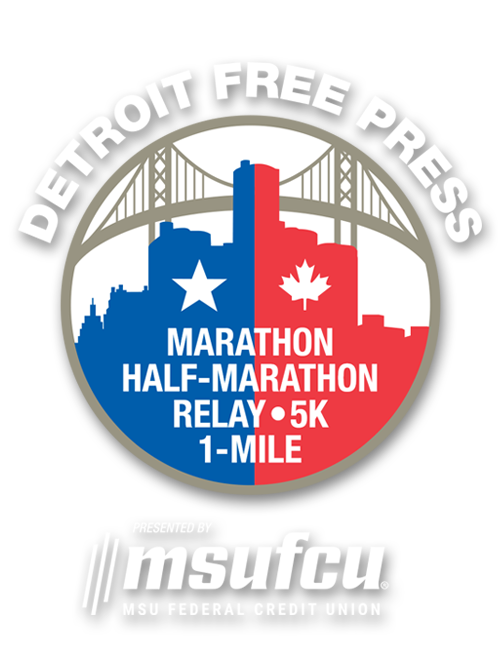When the young man in the old overcoat walked up to me that autumn morning in 1978 and told me that he had been instructed by God to run in the Free Press International Marathon, I was pleased with the serenity of my response.
It was Oct. 22, the day of the first Free Press marathon, and the disasters that preceded the event had left me that morning with an inner peace bordering on mysticism.
I had been battered and bumped for weeks with crises beyond comprehension or anticipation. With runners gathering under the starting banner, an intellectual tranquility had blessedly settled in. Now here in the pre-dawn chill in a Windsor park was a person in street clothes with a pair of running shoes strung around his neck insisting that he be allowed to fulfill God’s mission.
“When did God tell you to represent him in this race?” I inquired gently after identifying myself as the ranking temporal authority on the scene.
“Last night,” the man replied.
“Did God know that the deadline was two weeks ago?”
“God has no deadlines.”
I was nothing if not sublimely agreeable that morning and I told the man that he could run if God gave him a number.
God did not, because not even God could have figured out our numbering system that year and I knew it. It was one of the many things that had driven me to the ragged edge of despair in the summer and fall of 1978.
Today, several thousand runners will fill the streets of Windsor, Detroit, Grosse Pointe Park, City and Farms for the fifth running of this magnificent event. There are still the requisite amount of snags, glitches and foul-ups, but none to compare with the procession of disasters of that breech-born effort in 1978.
Our sister paper, the Charlotte (N.C.) Observer, sponsors an annual marathon in that city and all of us here thought about how much fun it would be to do the same thing in Detroit. We got the Motor City Striders behind us and set out to make it happen.
Ladd Neuman, our sports editor then, suggested we run it across the border and call it an international race. All we’d need would be permission from customs and immigration in two countries, permission from one foreign government and some people at the bridge or tunnel to let us run over or under the river.
I remember sitting in the office of Elliott Phillips, the president of the Detroit Canada Tunnel Corp., and getting the distinct impression that Mr. Phillips thought he had been descended upon by a collection of crazy people who wanted him to close the tunnel on a Sunday morning so a few thousand people could run through it.
The tunnel, he explained, had never been closed. Not for war, riot, famine, pestilence or anything else. He seemed under-intrigued by the idea of closing it for runners.
Customs and immigration officials from the U.S. and Canada outlined what seemed to be insurmountable problems involved in starting the race in one country and ending it in another.
We asked Burroughs Corp. to time the runners, even though it had never done anything like it before and wasn’t sure it wanted to. The police and various departments from the cities involved all had problems that needed to be overcome.
By September there were still dozens of snarls to be untangled and what had been a disaster in August was rapidly disintegrating.
I spent much of my time signing “hold harmless” agreements assuming full responsibility for whatever went wrong, which by late September was virtually everything.
I became convinced that when it all finally collapsed I would be, by virtue of my signature on all those documents, banished for life to a lonely exile on Peche Island. But for some reason, not explainable in worldly terms, it all came together.
Customs and Immigration said OK. The five cities involved worked out their problems. The tunnel folks agreed to close down and Burroughs became our official timer.
The night before the event, the pre-race banquet was held in an atmosphere totally in keeping with what had gone before. The people at the Sheraton-Cadillac forgot to set up tables and chairs in the dining room and everyone had to eat sitting on the floor. It was crowded and hot and the air conditioning didn’t work. And when somebody opened a window, it fell four floors to the street.
But the next day the race came off with a precision and beauty that made it look like it had been planned by people who knew what they were doing.
And, perhaps operating in the belief that the last shall be first, God’s numberless runner finished far back in the field.
Originally published Sunday, October 31, 1982 by Neal Shine in the Detroit Free Press. Neal Shine was the managing editor of the Detroit Free Press and first introduced the Detroit Free Press to the idea of a marathon race.
When the young man in the old overcoat walked up to me that autumn morning in 1978 and told me that he had been instructed by God to run in the Free Press International Marathon, I was pleased with the serenity of my response.
It was Oct. 22, the day of the first Free Press marathon, and the disasters that preceded the event had left me that morning with an inner peace bordering on mysticism.
I had been battered and bumped for weeks with crises beyond comprehension or anticipation. With runners gathering under the starting banner, an intellectual tranquility had blessedly settled in. Now here in the pre-dawn chill in a Windsor park was a person in street clothes with a pair of running shoes strung around his neck insisting that he be allowed to fulfill God’s mission.
“When did God tell you to represent him in this race?” I inquired gently after identifying myself as the ranking temporal authority on the scene.
“Last night,” the man replied.
“Did God know that the deadline was two weeks ago?”
“God has no deadlines.”
I was nothing if not sublimely agreeable that morning and I told the man that he could run if God gave him a number.
God did not, because not even God could have figured out our numbering system that year and I knew it. It was one of the many things that had driven me to the ragged edge of despair in the summer and fall of 1978.
Today, several thousand runners will fill the streets of Windsor, Detroit, Grosse Pointe Park, City and Farms for the fifth running of this magnificent event. There are still the requisite amount of snags, glitches and foul-ups, but none to compare with the procession of disasters of that breech-born effort in 1978.
Our sister paper, the Charlotte (N.C.) Observer, sponsors an annual marathon in that city and all of us here thought about how much fun it would be to do the same thing in Detroit. We got the Motor City Striders behind us and set out to make it happen.
Ladd Neuman, our sports editor then, suggested we run it across the border and call it an international race. All we’d need would be permission from customs and immigration in two countries, permission from one foreign government and some people at the bridge or tunnel to let us run over or under the river.
I remember sitting in the office of Elliott Phillips, the president of the Detroit Canada Tunnel Corp., and getting the distinct impression that Mr. Phillips thought he had been descended upon by a collection of crazy people who wanted him to close the tunnel on a Sunday morning so a few thousand people could run through it.
The tunnel, he explained, had never been closed. Not for war, riot, famine, pestilence or anything else. He seemed under-intrigued by the idea of closing it for runners.
Customs and immigration officials from the U.S. and Canada outlined what seemed to be insurmountable problems involved in starting the race in one country and ending it in another.
We asked Burroughs Corp. to time the runners, even though it had never done anything like it before and wasn’t sure it wanted to. The police and various departments from the cities involved all had problems that needed to be overcome.
By September there were still dozens of snarls to be untangled and what had been a disaster in August was rapidly disintegrating.
I spent much of my time signing “hold harmless” agreements assuming full responsibility for whatever went wrong, which by late September was virtually everything.
I became convinced that when it all finally collapsed I would be, by virtue of my signature on all those documents, banished for life to a lonely exile on Peche Island. But for some reason, not explainable in worldly terms, it all came together.
Customs and Immigration said OK. The five cities involved worked out their problems. The tunnel folks agreed to close down and Burroughs became our official timer.
The night before the event, the pre-race banquet was held in an atmosphere totally in keeping with what had gone before. The people at the Sheraton-Cadillac forgot to set up tables and chairs in the dining room and everyone had to eat sitting on the floor. It was crowded and hot and the air conditioning didn’t work. And when somebody opened a window, it fell four floors to the street.
But the next day the race came off with a precision and beauty that made it look like it had been planned by people who knew what they were doing.
And, perhaps operating in the belief that the last shall be first, God’s numberless runner finished far back in the field.
Originally published Sunday, October 31, 1982 by Neal Shine in the Detroit Free Press. Neal Shine was the managing editor of the Detroit Free Press and first introduced the Detroit Free Press to the idea of a marathon race.







